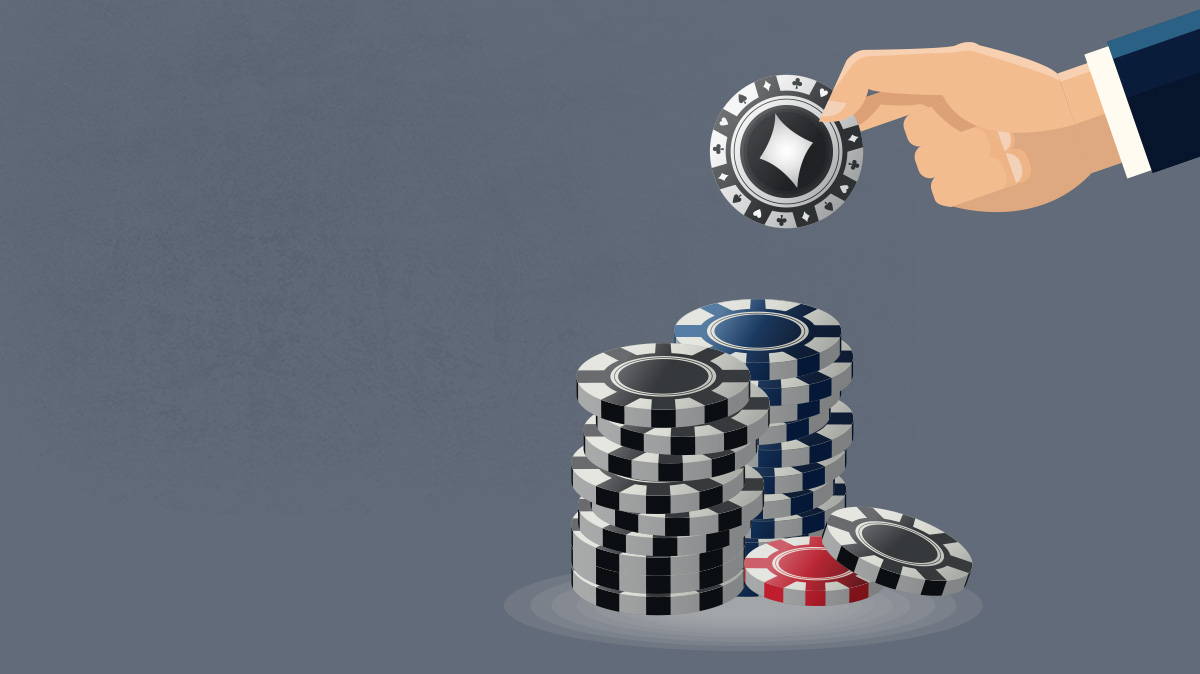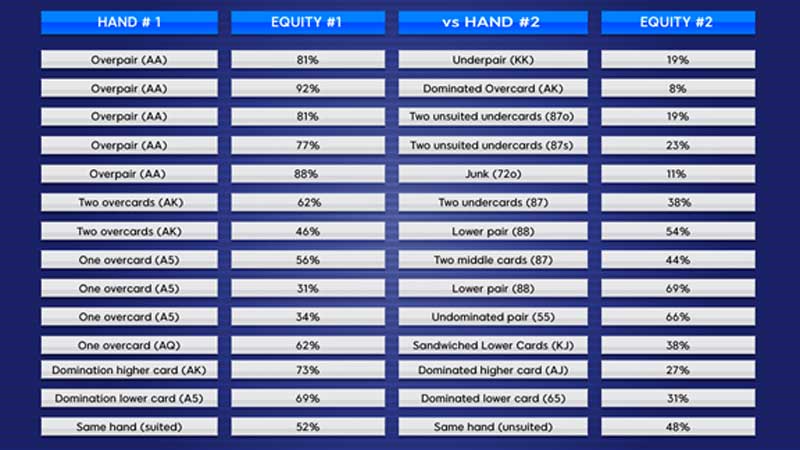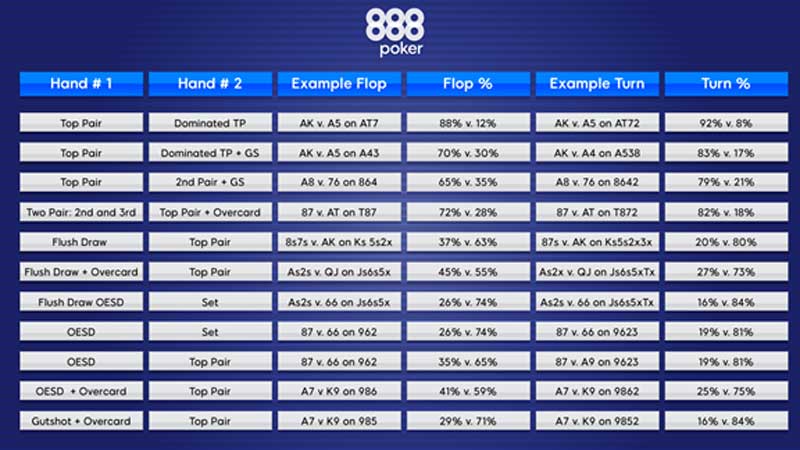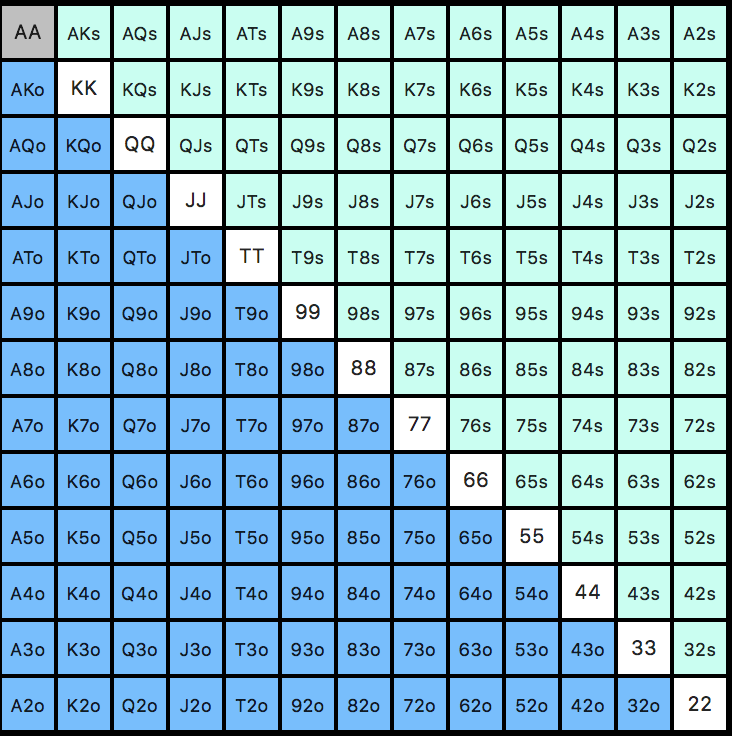A large part of building a solid poker strategy foundation comes from understanding the mathematical factors of the game.
Today, we’re going to take a look deeper at poker hand percentages – more specifically, Texas Hold’em poker hand percentages.
What Are Poker Percentages?
Poker percentages refer to the current chance of your hand winning at showdown. You may calculate them in any of the following formats:
- Hand vs Hand: Two known poker hands going up against each other
- Hand vs Range: One known poker hand going up against the entire range of an opponent’s possible hands.
- Range vs Range: No specific poker hands are known. The ranges of both players in the hand determine who might be more likely to win the hand. This calculation factors in all the possible holdings of each player.
Poker Equity vs Poker Percentages
“Poker equity” is a term often used in conjunction with “poker percentages”. Sometimes, players even use them synonymously or interchangeably.
- The “percentage” aspect refers to your chances of winning at showdown.
The “equity” aspect illustrates what portion of the pot should be yours right now. This number refers directly to your percent chance of winning the hand if showdown occurs. Poker Equity vs Poker Percentages
Poker Equity vs Poker Percentages
The Need for Understanding Poker Percentages
The greater understanding you gain of poker mathematics, the more naturally inclined you’ll be to make +EV decisions. This ability will win you money over the long run.
You’ll understand better when you may be ahead or behind. So, you’ll know when to take more of an aggressive or defensive approach to playing your hands.
As such, it’s essential to become accustomed to how different hands match up to each other, both preflop and postflop.
Poker Hand Percentages: Preflop
Poker starting hands percentages are calculated the following way –
- We take all the possible runouts of community cards. Then we see how often one player will win, lose, or tie versus their opponent’s holding.
Fortunately, in this computer age, we’re able to run these simulations rather quickly. So, discovering the preflop equities of various starting hands is simplistic.
Check out the following chart of the most common poker hands’ preflop percentages matchups:
 Poker Hand Percentages: Preflop
Poker Hand Percentages: Preflop
Notice that you’re always going to have some equity (or a percent chance of winning the pot at showdown). Many players take this one step too far, though.
- They take the adage literally, “You can’t win if you fold.”
So, they’ll punt off serious amounts of money to see a flop with nearly every hand!
If you’re struggling with your preflop game, check out this guide outlining how to play the most formidable starting hands in Hold’em.
Preflop Poker Strategy: Tight is Right!
Say you’re playing 6max or full-ring poker and always contributing that 1-3bb (or more!) to see the flop. This play is one of the worst things you can do to hurt your win rate.
Playing like this will add up in extremes over time. You’ll quickly realise that the pots you do win won’t offset those consistent micro losses by always seeing a flop.
As such, it’s crucial to note that playing a tighter (and also aggressive) strategy will be more conducive to winning.
Your 7-2 off-suit might have a bit of preflop equity against a random hand. But that doesn’t mean you should play it in the feeble hopes of hitting a dream 7-7-2 flop.
Poker Hand Percentages: Flop
Once the first three cards are out, it’s easier to calculate the poker percentages for the rest of the hand. There are only two cards to come post-flop versus preflop when there are five.
Use the following chart to review the heads-up equities from some common flop matchups:
 Poker Hand Percentages: Flop
Poker Hand Percentages: Flop
Poker Hand Percentages Calculator
It’s time-consuming to manually calculate the various possible board runouts and poker hand equities.
So, Poker Equity Calculators are fast and efficient tools that allow players to quickly see the hand's percentages.
In a hand vs hand situation, we recommend bookmarking our very own 888poker Odds Calculator.
This calculator will help you quickly determine the equities between two or more specific hands across any board runout you desire.
In any equity calculations involving ranges, it’s recommended to use Equilab (for Windows). Or use PokerCruncher (for Mac and iOS) for quickly calculating equities.
How To Work Out Percentages in Poker (Manually)
You’re not always going to have equity charts or poker calculators crunch all this crucial mathematical information.
In this section, we’ll show you a trick for estimating poker EV percentages in real-time and in-game.
| NOTE: This quick tip (outlined below) will apply more specifically to drawing hands where you need one or more cards to improve. (Click here for a refresher of poker hand rankings and to see what beats what in poker.) So, this shortcut will most commonly be applicable for straights and flushes. But you could use it with a one-pair hand and are looking for two-pair or three-of-a-kind outs – essentially, anything where you have “outs”. |
Calculating approximate poker EV percentages is relatively easy as long as you know how many outs you have.
- FLOP: Take your outs and multiply this by 4 to find the approximate % of making your draw by the river (turn or river)
- TURN: Take your outs and multiple this by 2 to find the approximate % chance of making your draw on the very next card (turn only or river only).
Refer to the chart below for odds of improving your hand on the turn or river (or both). You’ll also be able to deduce that the Rule of 2 and 4 outlined above isn’t a perfect solution. But it does give you a solid approximation, within a few percentage points, of improving your hand:
 How To Work Out Percentages in Poker (Manually)
How To Work Out Percentages in Poker (Manually)
Why You Can’t Only Rely On Your Outs Percentages
This chart isn’t a perfect solution for realising where you’re at in a poker hand when you factor in your opponent’s hand.
Imagine you have an Ace-high flush draw. With 9 outs to improve to a flush, you might calculate that you have about a ~36% chance of winning.
But this number isn’t necessarily accurate when you compare your hand to what your opponent might have:
- Perhaps your opponent might have a worse flush draw, meaning you’re beating your opponent currently. So, you might even have a bit of showdown value (SDV) with your Ace-high.
- Maybe you’ll be up against a hand like KK or QQ. So, in addition to your Ace-high flush draw, you also have an additional three outs. You could hit an Ace to improve to a one-pair hand better than your opponent.
The outs charts and techniques above give you a rough estimation for your hand to improve. But it’s also critical to consider what your opponent might have.
Compare your hand to their entire range to truly get a grasp of how you’re doing percentage-wise.
The Next Step: Percentages and Poker Ranges
Players will often do their best to memorise and understand the common preflop poker equities when taking a hand vs hand approach.
But the truth is, you can never pinpoint the specific holding your opponent has. So, it’s essential to work with ranges.
 Percentages and Poker Ranges
Percentages and Poker Ranges
The use of solvers in recent years has helped an incredible number of poker players. They have been able to surge to the forefront of optimal poker strategy using a range vs range approach.
A program like PioSolver allows players to input ranges of TWO opponents into the software. Then the program shows you the ideal betting lines and bet sizes you want to include in your game.
These solvers will also show you the following information:
- If you’re a range favourite on a board compared to your opponent.
- If you have a significant equity advantage or disadvantage when comparing ranges.
Typically, a significant range advantage is considered 55% equity or more. When you have a range equity advantage, you can confidently apply a great deal of pressure with a high frequency of small bets.
- RANGE ADVANTAGE EXAMPLE: Say you are the raiser preflop, and the board comes A-K-Q. You’ll have all the sets and two pair possibilities in your range. But your opponent can’t have these because they would’ve likely 3bet you preflop with QQ+ or AK/AQ.
Frequently Asked Questions: Poker Percentages
Q: How often does AA beat KK preflop in a poker game?
A: When all-in preflop, AA will beat KK about 81% of the time.
Q: How often will I hit my flush draw in poker?
A: With 9 outs and 2 cards to come, you have about a 35% chance of making your flush. With just 1 card to come, you have about a 19% chance.
Q: How often will I hit my open-ended-straight-draw (oesd) in poker?
A: With 8 outs and 2 cards to come, you have about a 32% chance of hitting your straight by the river. With just 1 card to come, you have about a 17% chance.
Q: What’s the ultimate draw in Texas Hold’em Poker?
A: The ultimate draw would be having a straight + flush draw + live overcards to your opponent’s hand.
- For example, your opponent has 22, and you have QJdd on T93ddx. You could hit any of the 9 flush cards, a King or Eight for 6 straight outs, or a Queen or Jack to improve to a pair (6 more outs).
That adds up to a crazy total of 21 total outs.!
You could also have the board double pair (counterfeiting your opponent’s Deuces). This scenario would increase your equity even more by about 2-3% for this backdoor possibility.
Q: How do I know if I “have the right price” to call with my draw?
After determining your per cent chance of improving, you’ll want to consider the pot odds you’re getting. This calculation will determine whether a call is +EV or not.
- For example, if someone bets ½-pot, you’re getting 3:1 on a call, meaning you only need 25% equity to continue.
If you don’t have the right express odds to call, you should take one of the following three actions:
- Fold
- Raise (to take down the pot immediately by getting your opponent to fold)
- Call based on implied odds. This move is assuming your opponent has enough money left to make calling worthwhile. And you believe you can win enough money from future bets if and after you hit.
Q: How can I improve my intuition for calculating equities/percentages between two hands? Can I get this for preflop, different flops and board textures?
Uhlvar Equity is a fantastic little program that allows you to see a poker scenario and guess each hand’s equity. After submitting your answer, the software will show you how close you were to being correct. So, you can improve your guesstimates with practice.
The Bottom Line: Poker Percentages Summary
Practice calculating poker equities and percentages. In time, you’ll become so much better at knowing where you stand in the hand.
Be sure to combine off-table study into your poker playing regimen. That way, you’ll improve your skills and abilities (like calculating poker percentages).
Eventually, these types of calculations will come more easily to you when you’re at the tables.


